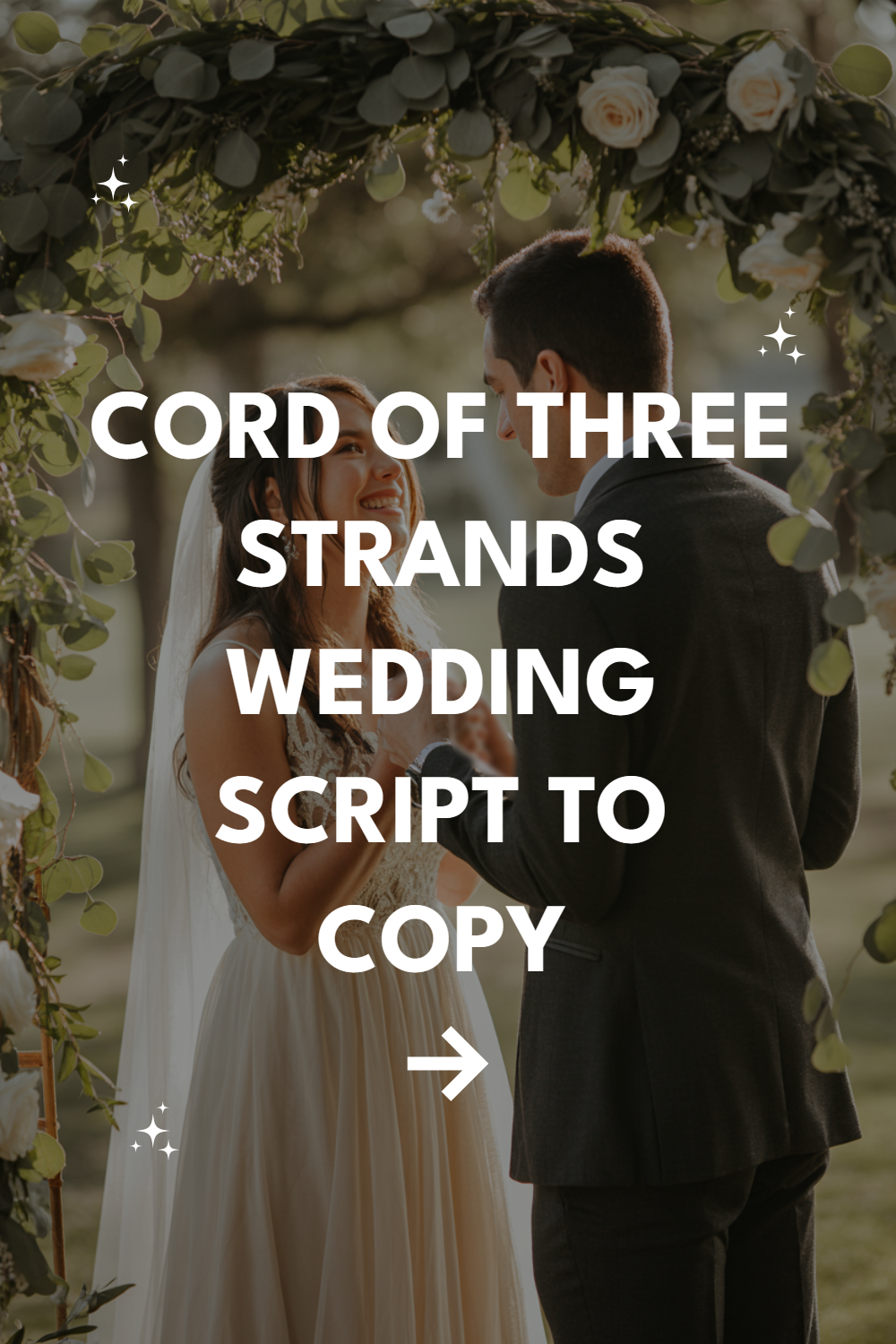The cord of three strands ceremony has become one of the most meaningful unity rituals couples choose for their wedding day. It’s simple, symbolic, and doesn’t require any special skills—just three cords, willing hands, and hearts ready to commit.
The Symbolism Behind Each Strand
Each strand carries weight in this ceremony. The first strand represents one partner—their individual strength, experiences, and the unique qualities they bring to the marriage.
The second strand symbolizes the other partner. Together, these two strands create a bond, but the ceremony acknowledges that even the strongest human connection has vulnerabilities.
The third strand completes the picture. Whether it represents divine presence, the support of family and community, or the shared values that bind the couple, this strand transforms a simple rope into something resilient.
Why Couples Choose This Unity Ritual
Unlike sand ceremonies or candle lighting, the cord ceremony creates something tangible that couples can take home. The braided cord becomes a physical reminder of their wedding day promises.
The ritual also works beautifully in any weather. Outdoor weddings don’t have to worry about wind extinguishing flames or rain dampening sand.
Complete Wedding Script for the Cord Ceremony
Here’s a ready-to-use script that your officiant can adapt to your specific needs and beliefs.
Opening Words from the Officiant
“Today, [Bride’s name] and [Groom’s name] have chosen to include the cord of three strands ceremony in their wedding. This beautiful ritual is based on the ancient wisdom that ‘a cord of three strands is not quickly broken.’
Before you are three individual cords. Separately, each has its own strength, but that strength has limits. When woven together, these strands create something far more resilient than any single thread could be alone.”
Explanation of Each Strand
“The first strand represents [Bride’s name]—your individual strength, your unique gifts, and everything you bring to this marriage. The second strand represents [Groom’s name]—your personal journey, your character, and your commitment to this union.
The third strand represents [God/your shared values/the love and support of your families and friends].
This strand acknowledges that your marriage is strengthened by forces beyond yourselves—whether that’s your faith, your community, or the principles that guide your life together.”
The Braiding Instructions
“Now, please take your cords. [Bride’s name], hold the strand that represents you and the strand that represents [spiritual element/community/shared values]. [Groom’s name], hold your strand and help guide the braiding process.
As you weave these strands together, remember that marriage requires this same intentional intertwining of your lives. Some days the braiding will feel effortless. Other days, it will require patience, attention, and the willingness to start over if the pattern goes wrong.”
Words During the Braiding
“With each twist of these strands, you’re creating something new. Your individual strengths aren’t disappearing—they’re becoming part of something greater. The challenges that might fray a single cord cannot easily break what you’re creating together.
This cord you’re braiding will serve as a reminder that your marriage is not just about two people choosing to be together. It’s about two people choosing to build something that can weather the storms life will bring.”
Closing Words
“[Bride’s name] and [Groom’s name], you now hold in your hands a cord of three strands—a symbol of your marriage and a reminder of the commitment you’ve made today.
Keep this cord in your home as a tangible reminder that what God has joined together, let no one separate. May your marriage be like this cord—strong, resilient, and beautiful in its unity.”
Customizing the Script for Different Beliefs
Not every couple shares the same spiritual background, and the cord ceremony adapts beautifully to different belief systems.
For Secular Ceremonies
Replace references to God with concepts like “the love and support of your community” or “the shared values that will guide your marriage.” The third strand can represent the couple’s commitment to growth, their shared dreams, or the foundation of trust they’ve built.
The symbolism remains powerful without religious language. Focus on the practical wisdom that relationships are stronger when they’re supported by something beyond just romantic feelings.
For Interfaith Couples
The third strand can represent the respect and understanding you’ve cultivated for each other’s beliefs. Alternatively, it can symbolize the common ground you’ve discovered despite different religious backgrounds.
This ceremony works particularly well for interfaith couples because it acknowledges that marriage draws strength from multiple sources without requiring identical beliefs.
For Religious Ceremonies
Traditional Christian ceremonies often include additional scripture readings or prayers. Consider adding 1 Corinthians 13 or having the congregation participate in a blessing over the couple during the braiding.
Jewish couples might incorporate Hebrew blessings, while couples from other faith traditions can weave in prayers or readings that reflect their spiritual journey together.
Practical Tips for a Smooth Ceremony
Choosing the Right Cords
Skip the thin, slippery ribbon that looks pretty but won’t cooperate during the ceremony. Choose cords that are thick enough to handle easily—about the width of a pencil works well.
Natural fiber cords like cotton or hemp braid more easily than synthetic materials. Avoid anything too rough or scratchy, since you’ll be handling it throughout the ceremony.
Color Coordination
| Color Choice | Symbolism | Practical Notes |
|---|---|---|
| White, White, Gold | Purity and divine blessing | Classic, photographs beautifully |
| Bride’s color, Groom’s color, White | Individual identity plus unity | Personalizes the ceremony |
| Three wedding colors | Cohesive with overall theme | Matches other décor elements |
| Natural hemp/jute | Rustic, authentic feel | Perfect for outdoor weddings |
Timing and Positioning
Position yourselves so wedding guests can see the braiding process. This isn’t a private moment—it’s a public declaration that benefits from witness.
Practice the braiding beforehand, but don’t stress about perfection. Slightly imperfect braiding often looks more authentic and relatable than a flawless rope.
Involving Family Members
Some couples invite their mothers or other family members to hold the cords steady during braiding. This variation emphasizes the community aspect of marriage and can be especially meaningful for blended families.
Children from previous relationships can participate by helping with the braiding or by adding additional strands to represent the new family unit being created.
Displaying Your Finished Cord
Shadow Box Presentation
Frame your braided cord in a shadow box alongside your wedding invitation or a photo from the ceremony. This creates a meaningful piece of wall art that tells your wedding story.
Add a small plaque with your wedding date and the Ecclesiastes verse, or choose a quote that reflects your personal interpretation of the ceremony’s meaning.
Anniversary Traditions
Some couples incorporate their cord into anniversary celebrations. On each wedding anniversary, they hold the cord together and reflect on how their marriage has grown stronger over the past year.
Others create new cords on milestone anniversaries, comparing them to their original wedding cord and discussing how their understanding of marriage has deepened.
Making the Ceremony Your Own
The beauty of the cord ceremony lies in its adaptability. Couples have created variations that reflect their unique stories and circumstances.
Adventure-loving couples have used climbing rope, emphasizing their shared love of challenge and exploration. Military families have incorporated paracord, highlighting themes of service and resilience.
Artists might choose materials that reflect their creative partnership, while couples who met through volunteer work might select cords in colors representing their shared cause.
Final Thoughts on Creating Lasting Memories
The cord of three strands ceremony offers something many wedding rituals lack—a permanent, tangible reminder of your wedding day promises.
Years later, when marriage feels more like work than romance, that braided cord serves as a physical reminder of the intentional choice you made to build something stronger together.
Your wedding day will blur into a beautiful haze of emotions, faces, and fleeting moments. But the cord you create together will remain, ready to remind you that some things in life are worth the effort of careful, patient weaving.


